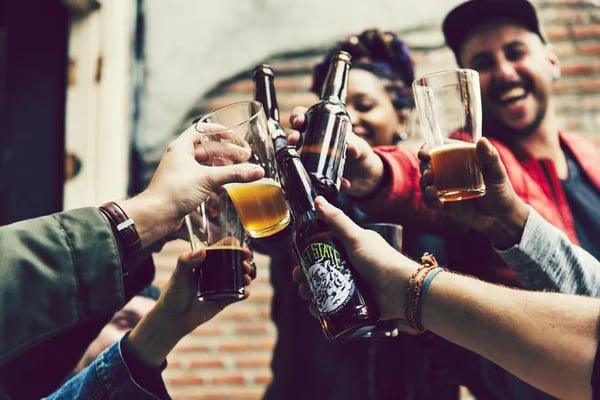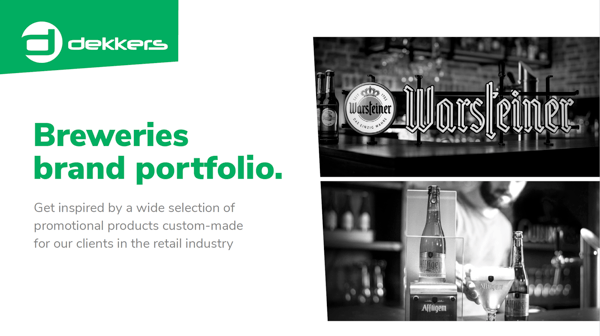 We recently spoke to Chief Economist Bart Watson from Brewers Association.org in preparation for the Craft Brewers Conference in Las Vegas. During our conversation, we discussed the latest craft beer market trends, risks, and opportunities. We also talked about the changes in the market over the last two years since our last conversation in 2022.
We recently spoke to Chief Economist Bart Watson from Brewers Association.org in preparation for the Craft Brewers Conference in Las Vegas. During our conversation, we discussed the latest craft beer market trends, risks, and opportunities. We also talked about the changes in the market over the last two years since our last conversation in 2022.
We asked Bart to provide an overview of the current market dynamics, including the main challenges and opportunities faced by new or established craft brewers in 2024. He shared valuable insights and tips for every craft beer brand builder to benefit from.
1. Q: Over the past two years, what have been the most notable shifts and developments in the craft beer market, and how have these changes influenced the strategies of craft brewers?
Over the past two years, the craft beer market has seen significant shifts and developments. These changes encompass market dynamics influenced by the COVID-19 pandemic, enduring challenges such as slowing demand growth and heightened competition, as well as a strategic focus on growth, differentiation, and aligning with evolving consumer trends. Craft brewers have proactively invested in enhancing their business operations to navigate challenges effectively, ensuring their long-term viability. There's been a notable emphasis on profitability, along with a recognition of the necessity to anticipate and adapt to future market shifts and consumer preferences.
The craft beer market is now considered more mature. Craft brewers are confronted with enduring challenges such as decelerating demand growth and an increasingly competitive landscape. The industry has transitioned beyond the rapid adoption phase, now prioritizing long-term strategies and innovative approaches to distinguish themselves in the market. This shows that the market has reached a level of maturity needing craft brewers to adapt and evolve continuously to keep their market share and foster customer loyalty.
2. Q: In 2022, you answered this question: If you look at the craft brewing industry in general, in the US, how would you describe its current state? Answering this question in 2024, what would you say about the current state?
In 2024, the craft brewing industry in the US is characterized by its maturity and heightened competitiveness. Craft brewers have navigated past the immediate challenges posed by the COVID-19 pandemic and are now confronted with longer-term issues, including decelerating demand growth and intensified competition. The industry has transitioned from the rapid adoption phase of five or ten years ago, with craft beer now occupying a more mainstream position in the market. Craft brewers are diligently focusing on identifying avenues for growth and formulating enduring strategies to thrive in this mature landscapeResponding to evolving consumer preferences is important. There's a noticeable trend towards high-ABV (higher alcohol by volume) beers such as double IPAs and low-ABV options like non-alcoholic beers and lagers. Craft brewers recognize the importance of differentiation and brand recognition in keeping their market share and fostering customer loyalty. Aligning brand values with the target demographic and investing in localized marketing and community engagement initiatives are pivotal strategies. Moreover, sustainability and digitalization have appeared as significant industry trends, offering craft brewers opportunities to distinguish themselves by integrating these values into their brand identity and operational practices.
3. Q: Is it still possible for new craft brewers to enter the market?
Yes, it is still possible for new craft brewers to enter the market. However, they need to differentiate themselves and bring something new to the market to be successful. This could include offering unique flavors or products, targeting specific demographics or occasions, or focusing on sustainability and community engagement. It is important for new brewers to have a clear brand identity and strategy that aligns with their target customers and sets them apart from the competition. Additionally, they should be prepared for the challenges of a competitive market and be willing to adapt and innovate to stay relevant
4. Q: Consumer preferences and behaviors are constantly evolving. What are some of the most significant trends you've observed in the craft beer market recently, and how are brewers adapting to meet changing consumer demands?
I’ve seen several significant trends in the craft beer market recently. These trends include a greater interest in high-ABV beers, such as double IPAs, as well as a growing demand for lower ABV options, including non-alcoholic beers and lagers. You see that consumers are becoming more intentional with their beer choices, considering the occasion and their values.
In terms of how brewers are adapting to these changing consumer demands, Bart explains that they are focusing on differentiation and aligning their brands with specific customer preferences. This includes developing products that cater to different occasions and demographics, as well as emphasizing sustainability and community engagement. “It’s becoming more important to have a holistic marketing strategy that integrates all aspects of the business, from product development to branding and community involvement.”
Overall, brewers are striving to build brand awareness and foster customer loyalty by understanding their target market and delivering products and experiences that align with their values and preferences.
5. Q: Supply chain disruptions and inflation have been ongoing challenges for craft brewers. What challenges are impacting the industry, and what innovative approaches are brewers employing to address them? Do you have any tips?
Supply chain disruptions and inflation are indeed still affecting the craft beer industry but in a different way than a couple of years ago. The immediate disruptions have largely passed, but there are still occasional flare-ups.
6. Q: Non-alcoholic beverages have been gaining popularity. How are craft brewers responding to this trend, and what opportunities do non-alcoholic offerings present for brewers of all sizes?
Craft brewers are indeed responding to the trend of non-alcoholic beverages gaining popularity. While not all brewers are investing in non-alcoholic offerings, there are opportunities for those who do. Non-alcoholic beverages require different technology and investment, so not all brewers may choose to produce them. However, brewers can still capitalize on the trend by understanding the underlying consumer needs and finding opportunities that align with their company.
For example, brewers could focus on producing non-alcoholic options like hop water or lower ABV beers, such as a 3.5% Radler. This comes down to the brewers understanding their customer base and what they are looking for and finding ways to differentiate their offerings in the market.
7. Q: Given the competitive landscape, including the rise of products like hard seltzers and canned cocktails, how can craft brewers differentiate their brands economically to maintain market share and customer loyalty?
Well, that's of course the million-dollar question. Overall, the key is for craft brewers to understand their target market, identify their unique value proposition, and consistently deliver on their brand promise. By differentiating themselves in the market and building strong customer relationships, craft brewers can maintain market share and customer loyalty in the competitive landscape. There is no one right way to do this; differentiation can be achieved through products, locations, branding, and services. The brewers that do it best are those that differentiate in all the above
8. Q: Localized marketing and community engagement are increasingly important for craft brewers. How can breweries economically invest in building brand awareness and fostering customer loyalty within their local markets?
Breweries can economically invest in building brand awareness and fostering customer loyalty within their local markets by differentiating their brand and aligning with their ideal target audience. What is the story you are trying to tell about your beer brand? Think this through and try a holistic approach. Be visible where your customers are, actively engage with them and show your commitment to meeting their needs.
9. Q: You mentioned that differentiation is a key factor. Sustainability can be a key theme here. Why is it important for breweries to show their actions about sustainability?
Differentiating on sustainability is one of the strategies that many craft brewers are adopting. Especially the younger generations, such as Gen Z, are more concerned about what companies do and expect to see their values reflected in the brands they support. Therefore, focusing on sustainability can help craft brewers attract and keep customers from these generations. However, sustainability is only one of many ways to differentiate, and each brewery should align its brand with its target audience and values.
10. Q: Do you see a significant difference between the US market and the international market in terms of beer trends?
Yes, there are some differences between the US market and the international market in terms of beer trends. The US market is more developed and mature compared to many international markets. Craft beer has been popular in the US for a longer time and has a larger market share. In international markets, craft beer is still growing and gaining popularity. However, there are also similarities in the trends seen in both markets, such as the focus on sustainability, localized marketing, and community engagement. Learning from the US brewing industry can help international brewers expect market challenges, adapt to changes, and achieve long-term success.
11. Q: As Chief Economist, what advice would you offer to craft brewers looking to strengthen their brand's economic resilience and long-term viability in today's competitive landscape?
We have dived into these factors in the answers above: Have a focus on differentiation and understanding your brand story and target audience. If you understand this, integrate this into all aspects of your business while engaging with the local community, and investing in marketing and brand awareness. This helps with being resilient and adaptable and keeps learning and improving continuously.
In conclusion, this interview with Bart Watson, Chief Economist at the Brewers Association, has shed light on the importance of profitability, adaptability and differentiation in the craft brewing industry. Watson emphasizes the need for breweries to focus on their internal resilience, identify potential risks and opportunities, and be prepared for future shifts in the market. He also highlights the role of the Brewers Association in providing support and guidance to its members. Want to hear more insights from Bart? Great news: He is one of the keynote speakers during the CBC (Craft Brewers Conference) 2024!





